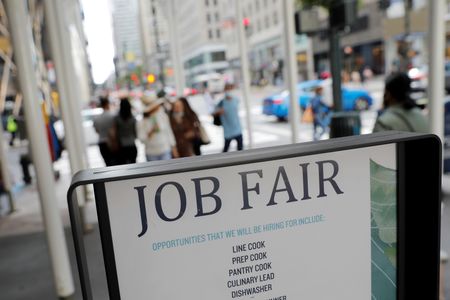
By Dan Burns
(Reuters) -The number of Americans filing new claims for unemployment benefits edged higher last week and a week earlier the total number on jobless assistance reached the highest since February, but both remain at levels indicating the U.S. job market remains tight, even as the Federal Reserve works to cool demand for labor as part of its bid to lower inflation.
Initial claims for state unemployment benefits rose 9,000 to a seasonally adjusted 225,000 for the week ended Dec. 24, the Labor Department said on Thursday, in line with the median estimate among economists polled by Reuters.
Meanwhile, the number of people receiving benefits after an initial week of aid rose 41,000 to 1.710 million in the week ending Dec. 17.
After hitting the lowest level since 1969 in May, those so-called continuing claims, a proxy for hiring, have drifted higher since early October. The latest report is the first since February to show them breaching the lower end of the 1.7-1.8 million trend that prevailed in the years leading up to the coronavirus pandemic, a level seen then as emblematic of a tight labor market.
And, while the figures for new benefits claims have been choppy in recent weeks, they have held well below the 270,000 threshold that economists see as a red flag for the labor market. A raft of layoffs in the technology sector and interest-rate sensitive industries like housing have yet to leave a notable imprint on claims as laid-off workers appear to cycle into new jobs with relative ease.
“Given the recent uptick in layoff announcements coming from large businesses, we would expect to see more of an increase in claims than we typically see at this time of year, but so far it hasn’t happened,” Thomas Simons, money market economist at Jefferies, said in a note.
It may also be that severance payments are causing a delay in when laid-off workers apply for benefits, Simons said, though “this is very hard to quantify.”
‘STRUCTURAL LABOR SHORTAGE’
Federal Reserve Chair Jerome Powell – the chief architect of the central bank’s aggressive interest rate hikes aimed at bringing too-high inflation to heel – earlier this month said “it feels like we have a structural labor shortage out there.”
Indeed, the labor market’s resilience is a central focus for Fed policymakers, as the U.S. economy has minted an average of 392,000 new jobs a month this year despite rapid rate hikes and growing fears of a recession next year. There were about 1.7 open jobs per unemployed individual as of October, roughly half a point above the openings-to-unemployed ratio seen before the pandemic.
Officials see that strength as providing ample room for them to continue to raise interest rates to bring down inflation, which by their preferred measure remains nearly three times their targeted level of 2% annually even if it has recently shown signs of heading lower.
The central bank has lifted rates from near zero in March to the current range of 4.25% to 4.50% and Fed officials project it will breach the 5% mark in 2023, a level not seen since 2007.
Fed officials also projected the unemployment rate could climb nearly a full percentage point to 4.6% next year, which at the current size of the U.S. workforce would equate to about 1.5 million job losses.
Achieving that, however, would require a substantial reversal of an employment growth trend that has persisted across the U.S. economy for more than a decade with the exception of the two months of historic job losses early in the coronavirus pandemic. The U.S. job market has recovered all of the 22 million positions cut during the COVID-19 lockdowns, and it has not experienced three or more months in a row of net payrolls declines since 2010.
Job growth through November had averaged nearly 400,000 a month, although that rate has tempered in the second half of the year. The average over the past three nonfarm payrolls reports from the government has been 272,000.
The Labor Department will report the U.S. employment figures for December on Jan. 6, and preliminary estimates from economists polled by Reuters see payrolls expanding this month by another 200,000. The unemployment rate is estimated to have remained unchanged at 3.7%.
Outplacement firm Challenger, Gray & Christmas next week will also update its tally of corporate layoff plans for December after its November report showed workforce reduction announcements were the highest since January 2021. Still, layoffs so far have been heavily concentrated in the technology sector that had boomed throughout the pandemic, and the year-to-date total number of announcements through last month were the second lowest on record dating to 1993.
Economists believe that companies are likely to cut back on hiring before embarking on layoffs. Employers have been generally reluctant to lay off workers after struggling to find labor during the COVID-19 pandemic.
“At least for the near-term, the JOLTS (Job Opening and Labor Turnover Survey) and NFIB (National Federation of Independent Business) data suggest that small businesses remain eager to absorb some workers laid off from larger businesses,” Simons said. “This dichotomy of demand cannot persist indefinitely, but it will help the labor market achieve a softer landing than it would otherwise.”
(Reporting by Dan Burns; Editing by Chizu Nomiyama)

